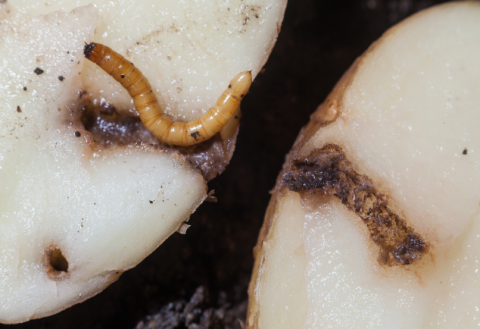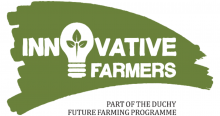Wireworms are the larval stage of click beetles. They cause stunted plant growth and damage, reducing yield and marketability in crops including root veg, cereals and lettuce, but particularly potatoes. Traditionally, wireworm damage was more prevalent in the east of England, but warming has caused a spread further west and north. Farmers on rented land have little or no control over field history, making it particularly risky to plant on tenanted land. The UK is behind many countries on research into risk assessment and the effectiveness of control strategies UK climate and soils.
Integrated Pest Management (IPM) strategies often emphasise controlling pests at their most vulnerable stage. Therefore, it is best to target control measures at larval stage to take advantage of wireworm’s life cycle, feeding habits and limited mobility.
Following an Innovative Farmers event on wireworm in potatoes with experts Martyn Cox (Blackthorn Arable), Dr Ben Clunie (Harper Adams University), Richard Griffith (Produce Solutions) and triallist Nick Taylor, this article looks at ways to assess risk and reduce wireworm populations in your fields.
How to assess and manage the risk of wireworm
1) Identify high-risk areas on your farm:
- Do you have lots of cereals in the rotation?
- Was cultivation in Aug/Sep avoided? No-till or reduced tillage systems create a favourable environment for wireworms as they prefer undisturbed soil.
- Is there weedy stubble? High amounts of crop residues left on the field after harvest provide shelter and food for wireworms.
- Are there areas of permanent grass or grassy margins nearby? Do you have short term grass, stewardship (2 years)? Certain cover crops, especially grasses, can serve as hosts for wireworms, providing them with a food source between cash crops.
- Are there rivers or reservoirs nearby? Wireworm likes damp and moist parts of fields and can survive in frequently wet areas including floodplains.
2) Create a plant-free situation after a cereal crop for a month.
3) Trapping and identification. Autumn is the best time for wireworm trapping in the UK. The soil temperature must remain above 8°C during the trapping period; aim for an average of 8°C, when they are closer to the surface. Spring trapping can work well but guidelines must be observed. Always use untreated seed; seed treated with chemicals could repel the pest and therefore ruin your assessments). For the most up to date guidance on how to bait trap, contact independent agronomist Martyn Cox (Blackthorn Arable).
3) Decide whether it is worth planting potatoes in the spring at all, or if alternative outlets, harvest dates are applicable.
4) Identify and isolate areas for early harvest. Late-lifted potatoes are associate with higher risk.
5) Consider which control strategies to apply as part of your IPM strategy (see below). These are most beneficial when combined, and include the use of biofumigant in crop rotation, resistant plant varieties, cultivations, and monitoring of wireworm populations.
Ways to control wireworm on your farm without chemicals
There is limited available data to support the effectiveness of granular nematicides against wireworm. Granular nematicides have been primarily designed to target the nervous system of plant-parasitic nematodes rather than wireworms, so are not a reliable treatment for wireworm infestations although fosthiazate can reduce damage. There may be additional unintended consequences on non-target organisms and the broader ecosystem.
Biofumigation
A mustard biofumigant crop releases natural compounds that can suppress soil-borne pests, pathogens and weeds including wireworm, PCN and verticillium wilt. The choice of mustard variety is important; studies abroad indicate that brown and hot mustard are particularly effective. It is crucial to incorporate the mustard into the soil for best results.
Biofumigation does not appear effective if there are volunteer cereals in the field, as those are highly attractive to wireworm; particularly maize and wheat, however there is insufficient data to confirm the degree to which biofumigant incorporation is still effective.
The Innovative Farmers field lab includes plots of buckwheat and mustard, comparing non-incorporated and incorporated to compare the biofumigant effect.
Buckwheat
Buckwheat planted in rotations prior to potatoes can be used for wireworm control due to its natural chemical properties that inhibit the development of wireworm. Research from Canada found that just 25% buckwheat in a mixed cover crop successfully suppressed wireworm, and that incorporating reduced the chances of it becoming a weed in the following year. Buckwheat is also fast-growing, improves soil and provides pollen and nectar sources.
Cultivations
Cultivations work best to expose pupae to predation from birds. Cultivation efforts should be focused in the early part of the autumn when larvae are most active. Cultivation can expose pupae, and/or disturb adults and larger larvae which in turn exposes them to predation. Cultivation can also remove food sources for young larvae.
Varietal selection
Select more wireworm-resistant potato varieties. CUPGRA work in 2022 found that Baby Lou and Melody were the least damaged varieties; Innovator and Maris Peer were the most damaged varieties.
Biological control + botanicals
Biological control products such as ATTRACAP® use granules containing a yeast which produces CO2 when in contact with soil moisture, attracting wireworms then infecting them with an insect-destroying fungus (entomopathogenic fungi, aka EPF). These EPF have the potential to offer good control but individual fungi and strains vary in suitability from both area and species, and more work is needed here. Both EPF and EPN (nematodes) have shown good potential.
To date, lab trials combining the antifungal effects of essential oils such as rosemary or tea-tree oil with the pathogenic activity of EPF have shown success in reducing the probability of larvae survival. Work by Dr Ben Clunie (unpublished PhD thesis) found that a reduced concentration of cedarwood oil boosted the effect of the EPF and reduced wireworm survival rate by up to 75%, greatly reducing the time-to-kill also. However, this area requires further research and may be expensive for growers.
Predatory control
Predators of wireworm include ground beetles, birds, nematodes, stiletto fly larvae, mites, beneficial microorganisms like entomopathogenic fungi mentioned above, and wireworm themselves. Focusing efforts on improving predatory control has limited efficacy on its own, but to create conditions for natural predators to thrive, minimise the use of broad-spectrum insecticides.



